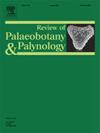A new species of the fossil fern Millerocaulis (Osmundales: Osmundaceae) from the Snow Hill Island Formation (Upper Cretaceous) of James Ross Island, Antarctic Peninsula
IF 1.7
3区 地球科学
Q2 PALEONTOLOGY
引用次数: 0
Abstract
A small permineralized stem containing an ectophloic-dictyoxylic siphonostele and petiole bases with an homogeneous sclerotic ring, referable to the fossil genus Millerocaulis Erasmus ex Tidwell emend. Vera, was recovered from the siltstones of the Gamma Member of the Snow Hill Island Formation (Marambio Group, Upper Cretaceous) of Santa Marta Cove, James Ross Island. The presence of high numbers of xylem strands, leaf traces per cross section, wide cauline xylem strands and lack of sclerenchyma in the petiole bases (apart from the sclerotic ring) at least until the fourth petiolar cycle allow its separation from other known species of the genus Millerocaulis, defining a new taxon Millerocaulis santamartaensis sp. nov.. This new taxon represents the fourth species of the genus identified from Antarctica. The fossil bearing strata are interpreted as upper Campanian to lower Maastrichtian. As a result, M. santamartaensis sp. nov. represents the youngest evidence of the presence of this genus of stem-Osmundaceae almost until the end of the Cretaceous.
南极半岛詹姆斯罗斯岛雪山岛组(上白垩纪)蕨类化石Millerocaulis一新种(Osmundales: Osmundaceae)
一种小的过矿化茎,包含一个外胚芽-二氧基虹吸管和叶柄基部,有一个均匀的硬化环,可参考化石属Millerocaulis Erasmus ex Tidwell修订。Vera是从James Ross岛Santa Marta Cove的Snow Hill Island Formation (Marambio Group,上白垩纪)的Gamma成员的粉砂岩中回收的。木质部链数高,每横截面有叶迹,茎部木质部链宽,叶柄基部缺乏厚壁组织(除了硬化环),至少到第四个叶柄循环,使其与其他已知的千禧年属物种区分开来,定义了一个新的分类单元Millerocaulis santamartaensis sp. nov。这一新分类群是在南极洲发现的该属的第四种。含化石地层解释为上坎帕尼亚至下马斯特里赫特。因此,M. santamartaensis sp. 11 .代表了几乎直到白垩纪末期这一茎- osmundaceae属存在的最年轻证据。
本文章由计算机程序翻译,如有差异,请以英文原文为准。
求助全文
约1分钟内获得全文
求助全文
来源期刊
CiteScore
3.50
自引率
21.10%
发文量
149
审稿时长
6 months
期刊介绍:
The Review of Palaeobotany and Palynology is an international journal for articles in all fields of palaeobotany and palynology dealing with all groups, ranging from marine palynomorphs to higher land plants. Original contributions and comprehensive review papers should appeal to an international audience. Typical topics include but are not restricted to systematics, evolution, palaeobiology, palaeoecology, biostratigraphy, biochronology, palaeoclimatology, paleogeography, taphonomy, palaeoenvironmental reconstructions, vegetation history, and practical applications of palaeobotany and palynology, e.g. in coal and petroleum geology and archaeology. The journal especially encourages the publication of articles in which palaeobotany and palynology are applied for solving fundamental geological and biological problems as well as innovative and interdisciplinary approaches.

 求助内容:
求助内容: 应助结果提醒方式:
应助结果提醒方式:


